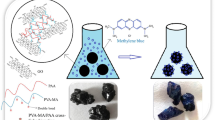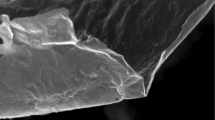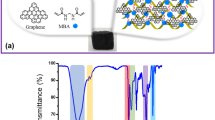Abstract
In this work, pH-sensitive hydrogel nanocomposites based on the acrylic acid (AA), graphene oxide (GO) and monoacryloyl tetraammonium thiacalix[4]arene (MATCA) was conveniently prepared via heterogenious copolymerization using methylene bisacrylamide (MBA) and azobisisobutyronitrile (AIBN) as crosslinker and initiator, respectively. The prepared hydrogel nanocomposites showed excellent capability for water absorption up to 67.5 g/g. The pH-sensitive nanocomposite (MATCA-co-AA@GO) with tunable properties was utilized for removing dye pollutant such as malachite green (MG) and methylene blue (MB) dyes from wastewater. The dye removal efficiency up to 95% was achieved at optimum pH of 6.5. FTIR, 1H and 13C NMR spectroscopies, CHNSO elemental analysis, mass spectroscopy, TGA, XRD, CHNSO, DMTA and FESEM were used to characterize and study the synthesized materials. In isotherm studies of adsorption, the Freundlich isotherm provided a better fit to the data of MG adsorption. However, in the case of MB, the results are compatible to langmiur isotherm. Results obtained through the kinetic investigations showed that the adsorption of MG and MB on to MATCA-co-AA@GO nanocomposite followed a pseudo-second-order kinetic model. The maximum adsorption capacity (Qm) was 67.5 and 70.3 mg g−1 for MG and MB respectively. Besides, from the thermodynamic data, the adsorption process was suggested to be chemisorption, spontaneous, and endothermic. Reusability of the prepared sorbent was examined by consecutive adsorption/desorption experiments. The prepared adsorbent is recyclable and represents a good candidate for extremely effective sequential removal of MG and MB dyes from wastewater.













Similar content being viewed by others
References
Hieu C, Juang R (2019) Efficient removal of cationic dyes from water by a combined adsorption-photocatalysis process using platinum-doped titanate nanomaterials. J Taiwan Inst Chem Eng 99:166–179. https://doi.org/10.1016/j.jtice.2019.03.017
Srivastava S, Sinha R, Roy D (2004) Toxicological effects of malachite green. Aquat Toxicol 66:319–329. https://doi.org/10.1016/j.aquatox.2003.09.008
Mohd Noor NF, Yusoff SFM (2020) Ultrasonic-enhanced synthesis of rubber-based hydrogel for waste water treatment: Kinetic, isotherm and reusability studies. Polym Test 81:106200. https://doi.org/10.1016/j.polymertesting.2019.106200
Rafatullah M, Sulaiman O, Hashim R, Ahmad A (2010) Adsorption of methylene blue on low-cost adsorbents: A review. J Hazard Mater 177:70–80. https://doi.org/10.1016/j.jhazmat.2009.12.047
Nethaji S, Sivasamy A, Thennarasu G, Saravanan S (2010) Adsorption of Malachite Green dye onto activated carbon derived from Borassus aethiopum flower biomass. J Hazard Mater 181:271–280. https://doi.org/10.1016/j.jhazmat.2010.05.008
Preethi S, Sivasamy A, Sivanesan S et al (2006) Removal of Safranin Basic Dye from Aqueous Solutions by Adsorption onto Corncob Activated Carbon. Ind Eng Chem Res 45:7627–7632. https://doi.org/10.1021/ie0604122
Zhang PB, Tang AQ, Wang ZH, et al (2018) Tough poly(L-DOPA)-containing Double Network Hydrogel Beads with High Capacity of Dye Adsorption. Chinese J Polym Sci (English Ed 36:1251–1261. https://doi.org/10.1007/s10118-018-2163-2
Khattri SD, Singh MK (2009) Removal of malachite green from dye wastewater using neem sawdust by adsorption. J Hazard Mater 167:1089–1094. https://doi.org/10.1016/j.jhazmat.2009.01.101
Lakouraj MM, Norouzian RS, Balo S (2015) Preparation and Cationic Dye Adsorption of Novel Fe3O4 Supermagnetic/Thiacalix[4]arene Tetrasulfonate Self-Doped/Polyaniline Nanocomposite: Kinetics, Isotherms, and Thermodynamic Study. J Chem Eng Data 60:2262–2272. https://doi.org/10.1021/acs.jced.5b00080
Pourjavadi A, Abedin-Moghanaki A (2016) Ultrafast and efficient removal of cationic dyes using a magnetic nanocomposite based on functionalized cross-linked poly(methylacrylate). React Funct Polym 105:95–102. https://doi.org/10.1016/j.reactfunctpolym.2016.05.016
Kumar R, Sharma RK, Singh AP (2019) Synthesis and characterization of cellulose based graft copolymers with binary vinyl monomers for efficient removal of cationic dyes and Pb(II) ions. J Polym Res 26. https://doi.org/10.1007/s10965-019-1790-9
Chowdhury S, Mishra R, Saha P, Kushwaha P (2011) Adsorption thermodynamics, kinetics and isosteric heat of adsorption of malachite green onto chemically modified rice husk. Desalination 265:159–168. https://doi.org/10.1016/j.desal.2010.07.047
Zhang J, Li Y, Zhang C, Jing Y (2008) Adsorption of malachite green from aqueous solution onto carbon prepared from Arundo donax root. J Hazard Mater 150:774–782. https://doi.org/10.1016/j.jhazmat.2007.05.036
Narimani F, Lakouraj MM (2015) Swelling behavior and characterization of alcohol-specific superabsorbing gels based on acrylic acid and allyl tetrasodium thiacalix[4]arene tetrasulfonate. J Polym Res 22:1–6. https://doi.org/10.1007/s10965-015-0670-1
Bai H, Li C, Wang X, Shi G (2010) A pH-sensitive graphene oxide composite hydrogel. Chem Commun 46:2376–2378. https://doi.org/10.1039/c000051e
Mohamed MG, Ahmed AFM, EL-Mahdy, Meng TS et al (2020) Multifunctional Hypercrosslinked Porous Organic Polymers Based on Tetraphenylethene and Triphenylamine Derivatives for High-Performance. Polymers (Basel) 12:2426. https://doi.org/10.3390/polym12102426
Narimani F, Mansour Lakouraj M (2015) Synthesis and characterization of super dye adsorbent hydrogels based on acrylic acid and acryloyl tetrasodium thiacalix[4]arene tetrasulfonate. Polym Int 64:1482–1490. https://doi.org/10.1002/pi.4946
Kamboh MA, Solangi IB, Sherazi STH, Memon S (2011) A highly efficient calix[4]arene based resin for the removal of azo dyes. Desalination 268:83–89. https://doi.org/10.1016/j.desal.2010.10.001
Mohammadi A, Lakouraj MM, Barikani M (2014) Preparation and characterization of p-tert-butyl thiacalix[4]arene imbedded flexible polyurethane foam: An efficient novel cationic dye adsorbent. React Funct Polym 83:14–23. https://doi.org/10.1016/j.reactfunctpolym.2014.07.003
Lakouraj MM, Tashakkorian H (2013) Synthesis and thermophysical properties of nanocrystalline polycalix[4]amides and polycalix[4]arene containing mesogenic triazole units and their heavy metal sorption. Supramol Chem 25:221–232. https://doi.org/10.1080/10610278.2012.758366
Duan J, Xie Y, ning, Yang J hui, et al (2016) Graphene oxide induced hydrolytic degradation behavior changes of poly(L-lactide) in different mediums. Polym Test 56:220–228. https://doi.org/10.1016/j.polymertesting.2016.10.015
Fan L, Luo C, Sun M et al (2012) Preparation of novel magnetic chitosan/graphene oxide composite as effective adsorbents toward methylene blue. Bioresour Technol 114:703–706. https://doi.org/10.1016/j.biortech.2012.02.067
Dreyer DR, Park S, Bielawski CW, Ruoff RS (2010) The chemistry of graphene oxide. Chem Soc Rev 39:228–240. https://doi.org/10.1039/b917103g
Potts JR, Dreyer DR, Bielawski CW, Ruoff RS (2011) Graphene-based polymer nanocomposites. Polymer (Guildf) 52:5–25. https://doi.org/10.1016/j.polymer.2010.11.042
Chen Y, Chen L, Bai H, Li L (2013) Graphene oxide-chitosan composite hydrogels as broad-spectrum adsorbents for water purification. J Mater Chem A 1:1992–2001. https://doi.org/10.1039/c2ta00406b
Kumagai H, Hasegawa M, Miyanari S et al (1997) Facile synthesis of p-tert-butylthiacalix[4]arene by the reaction of p-tert-butylphenol with elemental sulfur in the presence of a base. Tetrahedron Lett 38:3971–3972. https://doi.org/10.1016/S0040-4039(97)00792-2
Marcano DC, Kosynkin DV, Berlin JM et al (2010) Improved synthesis of graphene oxide. ACS Nano 4:4806–4814. https://doi.org/10.1021/nn1006368
Kasyan O, Swierczynski D, Drapailo A et al (2003) Upper rim substituted thiacalix[4]arenes. Tetrahedron Lett 44:7167–7170. https://doi.org/10.1016/S0040-4039(03)01809-4
Hu X, Zhu Z, Shen T et al (2004) Synthesis of the tetranitro derivative of thiacalix[4]arene and its acid-base properties. Can J Chem 82:1266–1270. https://doi.org/10.1139/v04-090
Desroches C, Parola S, Vocanson F et al (2002) Nitration of thiacalix[4]arene using nitrosium nitrate complexes: Synthesis and characterization of tetranitro-, tetraamino-, and tetra(4-pyridylimino)tetrahydroxythiacalix[4]arene. New J Chem 26:651–655. https://doi.org/10.1039/b110609k
Shen J, Yan B, Li T et al (2012) Mechanical, thermal and swelling properties of poly(acrylic acid)-graphene oxide composite hydrogels. Soft Matter 8:1831–1836. https://doi.org/10.1039/c1sm06970e
Chen W, Yan L, Bangal PR (2010) Preparation of graphene by the rapid and mild thermal reduction of graphene oxide induced by microwaves. Carbon N Y 48:1146–1152. https://doi.org/10.1016/j.carbon.2009.11.037
Maurer JJ, Eustace DJ, Ratcliffe CT (1987) Thermal Characterization of Poly(acrylic acid). Macromolecules 20:196–202. https://doi.org/10.1021/ma00167a035
Park Y, Lee S, Ha SS et al (2019) Crosslinking effect on thermal conductivity of electrospun poly(acrylic acid) nanofibers. Polymers (Basel) 11:1–13. https://doi.org/10.3390/polym11050858
Akceylan E, Bahadir M, Yilmaz M (2009) Removal efficiency of a calix[4]arene-based polymer for water-soluble carcinogenic direct azo dyes and aromatic amines. J Hazard Mater 162:960–966. https://doi.org/10.1016/j.jhazmat.2008.05.127
Ai L, Zhang C, Chen Z (2011) Removal of methylene blue from aqueous solution by a solvothermal-synthesized graphene/magnetite composite. J Hazard Mater 192:1515–1524. https://doi.org/10.1016/j.jhazmat.2011.06.068
Huang Y, Zeng M, Ren J et al (2012) Preparation and swelling properties of graphene oxide / poly (acrylic acid-co- acrylamide) super-absorbent hydrogel nanocomposites. Colloids Surfaces A Physicochem Eng Asp 401:97–106. https://doi.org/10.1016/j.colsurfa.2012.03.031
Zeng M, Huang Y, Lu L et al (2011) Effects of filler-matrix morphology on mechanical properties of corn starch-zein thermo-moulded films. Carbohydr Polym 84:323–328. https://doi.org/10.1016/j.carbpol.2010.11.038
Boparai KS, Singh R (2018) Thermoplastic composites for fused deposition modeling filament: challenges and applications. Ref Modul Mater Sci Mater Eng 1–14. https://doi.org/10.1016/b978-0-12-803581-8.11409-2
Yan H, Tao X, Yang Z et al (2014) Effects of the oxidation degree of graphene oxide on the adsorption of methylene blue. J Hazard Mater 268:191–198. https://doi.org/10.1016/j.jhazmat.2014.01.015
Zhao T, Zhang K, Chen J et al (2019) Changes in heavy metal mobility and availability in contaminated wet-land soil remediated using lignin-based poly(acrylic acid). J Hazard Mater 368:459–467. https://doi.org/10.1016/j.jhazmat.2019.01.061
Sekhavat Pour Z, Ghaemy M (2015) Removal of dyes and heavy metal ions from water by magnetic hydrogel beads based on poly(vinyl alcohol)/carboxymethyl starch-g-poly(vinyl imidazole). RSC Adv 5:64106–64118. https://doi.org/10.1039/c5ra08025h
Sun H, Cao L, Lu L (2011) Magnetite/reduced graphene oxide nanocomposites: One step solvothermal synthesis and use as a novel platform for removal of dye pollutants. Nano Res 4:550–562. https://doi.org/10.1007/s12274-011-0111-3
El-Sayed GO (2011) Removal of methylene blue and crystal violet from aqueous solutions by palm kernel fiber. Desalination 272:225–232. https://doi.org/10.1016/j.desal.2011.01.025
Ramírez E, Burillo SG, Barrera-Díaz C et al (2011) Use of pH-sensitive polymer hydrogels in lead removal from aqueous solution. J Hazard Mater 192:432–439. https://doi.org/10.1016/j.jhazmat.2011.04.109
Chen Z, Zhang J, Jianwei Fu MW et al (2014) Adsorption of methylene blue onto poly(cyclotriphosphazene-co-4,4′-sulfonyldiphenol) nanotubes: kinetics, isotherm and thermodynamics analysis. J Hazard Mater. https://doi.org/10.1016/j.jhazmat.2014.03.053
Bagheri N, Lakouraj MM, Hasantabar V, Mohseni M (2021) Biodegradable macro-porous CMC-polyaniline hydrogel: synthesis, characterization and study of microbial elimination and sorption capacity of dyes from waste water. J Hazard Mater 403:123631. https://doi.org/10.1016/j.jhazmat.2020.123631
Naseeruteen F, Hamid NSA, Suah FBM et al (2018) Adsorption of malachite green from aqueous solution by using novel chitosan ionic liquid beads. Int J Biol Macromol 107:1270–1277. https://doi.org/10.1016/j.ijbiomac.2017.09.111
Rangabhashiyam S, Lata S, Balasubramanian P (2018) Biosorption characteristics of methylene blue and malachite green from simulated wastewater onto Carica papaya wood biosorbent. Surfaces and Interfaces 10:197–215. https://doi.org/10.1016/j.surfin.2017.09.011
Baldez EE, Robaina NF, Cassella RJ (2008) Employment of polyurethane foam for the adsorption of Methylene Blue in aqueous medium. J Hazard Mater 159:580–586. https://doi.org/10.1016/j.jhazmat.2008.02.055
Masoumi A, Ghaemy M (2014) Removal of metal ions from water using nanohydrogel tragacanth gum-g-polyamidoxime: Isotherm and kinetic study. Carbohydr Polym 108:206–215. https://doi.org/10.1016/j.carbpol.2014.02.083
Acknowledgements
We appreciate the council of University of Mazandaran for the partial financial support of this work.
Author information
Authors and Affiliations
Corresponding author
Ethics declarations
Conflict of interest
The authors declare that they have no any competing financial interests or personal relationships.
Additional information
Publisher's Note
Springer Nature remains neutral with regard to jurisdictional claims in published maps and institutional affiliations.
Supplementary Information
Below is the link to the electronic supplementary material.
Rights and permissions
About this article
Cite this article
Niknezhad, M., Mansour Lakouraj, M. Development of pH-sensitive hydrogel nanocomposite based on acrylic acid/ graphene oxide/acryloyl tetra ammonium thiacalix[4]arene for separation of cationic dyes. J Polym Res 28, 209 (2021). https://doi.org/10.1007/s10965-021-02510-4
Received:
Accepted:
Published:
DOI: https://doi.org/10.1007/s10965-021-02510-4




